
October, 1951, Winfield Scotland. Scuderia Ambrosiana’s F2 Ferrari being rolled out of the 1936 Leyland Tiger modified bus belonging to Merchiston Motors. Most teams had to convert busses and trucks to fit their needs.
Inside the Paddock, Racing Car Transporters at Work by David Cross and Bjorn Kjer
ISBN 978-1-85443-254-4
Dalton Watson Fine Books, Deerfield IL 2012
229mm by 290 mm, 392 pages, Hard cover with dust jacket, 550 mainly B&W photos
US $89 Order Here or at 1-847-945-0568
Review by Pete Vack
Ah hold off a bit…this book is about trucks in the paddock-not cars! Lorries, those wonderful, huge, largely ignored devices that somehow managed to get their payload to the grids across Europe just in time for practice. Well, perhaps just in time to make the grid was more like it.
This book is just in time too. Very little, if anything has been published or written on those magnificent elephants that would hide in plain sight in paddocks. At races, all eyes and cameras focused on the valuable awe inspiring race cars that were carefully unloaded from their bays. Usually parked side by side and hidden by other vehicles front and rear, the racing lorries were simply not all that photogenic. In spite of this, David Cross has come up with over 550 mainly black and white photographs to illustrate this very worthwhile labor of love.
Cross created over 150 individual chapters covering just about any European team, Ecurie, Scuderia, drivers, private entries and all major manufacturer such as Alfa, Ferrari, Maserati, Mercedes, Porsche, etc.
Transporters weren’t always ignored of course. When Mercedes-Benz decided to make a 100 mph single car transporter in the mid fifties, they got their PR’s worth with the “Blue Wonder”. When Ecurie Ecosse (See Gauld’s story in this edition) created a new transporter with twin fins, it got a lot of attention. The Ferrari Bartoletti’s got a fair bit of press, ink and pixels over the years of the 1950s.
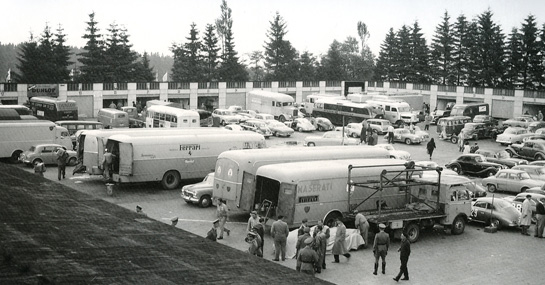
A great overall view of the paddock area at the Nurburgring in 1956, with transporters from Ferrari, Maserati, Gordini, and many others. Hard to see the forest for the trees while on the ground, resolved by shots like this. Credit Anthony Carter.
Still most of us were in the dark. How many among us can really see the Scuderia Lancia’s 250 Hp Esatau P that was specially built for the Lancia Racing Department in our mind’s eye? Dim, I’ll bet. What about the much vaunted Pegaso Transporter, a racy and sleek as the cars they hauled (for a few times!).

At the 1924 Italian Grand Prix Mercedes-Benz used one of the first purpose-built race car hauler. This was a modified Mercedes T 24/100/140PS and preceded the famous Blue Wonder by 30 years. Credit Mercedes Benz-Classic.
Ok, how about the square-rigged Guy Van that John Cooper used for his F1 cars between 1966 and 1968? And I’m sure everyone can still recall the details of the Fiat Bartoletti that took the famous Cobra Daytona coupes from victory to victory in Europe in 1964. (see Racing Car Transport Art)
So we are impressed. This is a neat book, much needed whether one is a historian, modeler, journalist, or just crazy about cars and racing.
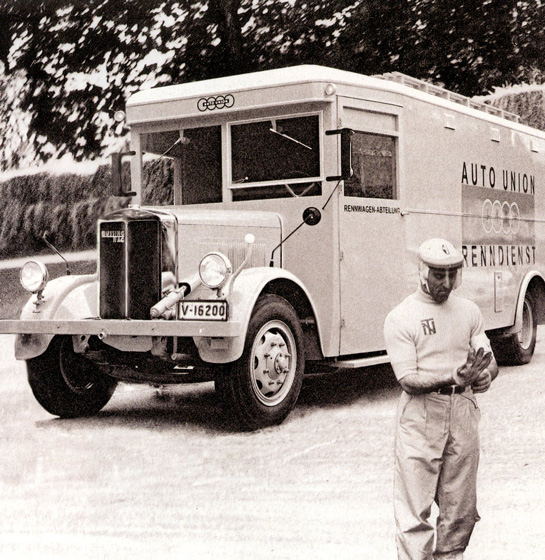
At the 1938 Italian Grand Prix Auto Union was using several of these Bussing transporters to efficiently get the cars to the track. It was one car per truck in this case. That’s Tazio Nuvolari in the foreground. Credit Unternehmensarchiv der Audi AG.
David Cross and truck expert Bjorn Kjer (I don’t know squat about trucks, so Bjorn’s specialized interest in lorries is well used here) have put together a fascinating book. How does one go about getting arms and hands around the organization? Perhaps by categorizing each truck type? Perhaps by discussing each era? How about by race manufacturer? They came up with a solution that works; alphabetical, in general by race team. Cooper under C, Ferrari under F, and individuals as well…Stirling Moss had a nice van before his Mercedes day…wealthy amateurs like Rivers Fletcher, “Garagistis” like Mike Hawthorn, and teams like Ecurie Ecosse come under the system quite well. There are also indexes by proper names, Manufacturer’s Index and Coachbuilders.
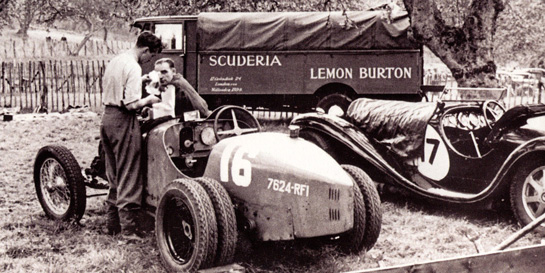
Privateers often had to make do with cake trucks with the tops cut off. Brit Lemon Burton was a founding member of the Bugatti Owner’s Club and competed in many events before and after the War. Here is his T51 in an idyllic scene at Prescott in September 1955. Credit Bugatti Trust.
And how might one limit the subject? It is surprisingly large and in depth. Although many team cars were driven to the events on public roads, WWI saw the rapid development of trucks and there use became widespread during the 1920s. Race cars were hauled in every way imaginable, and Cross has found both great images and great art that depict the early years of tough hauling. Under B we’ll find three Bugatti sections; Bugatti—figments of the imagination, Bugatti Privateers and Bugatti by Chevrolet! It is by no means comprehensive nor does it claim to be. Cross has deliberately limited this volume to European and U.K. races and then limits the subject further by ignoring almost all transporters post 1970s, when the ubiquitous 18 wheelers and standardization came to pass.
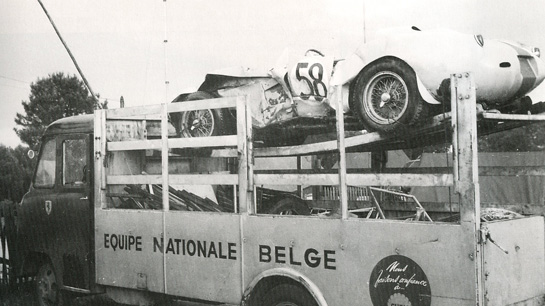
Even in the 1950s, many race cars were driven to the races, but having an accident while at the track caused problems. This is the Mairesse 250TR after his accident at Le Mans in 1958, definitely in need of a ride from this Belgian built Ford P model. Credit Anthony Carter.
This reviewer can totally agree on that point. What makes the book and the subject charming and of continued interest are the many variations of trucks, lorries, trailers, vans, busses and stake trucks that made each one unique inside and out. In fact, one of the problems for race car team owners was that there were few if any firms that specialized in the specific design and construction of a race car hauler/shop, at least until the advent of the 1970s. Teams like Gordini, Pegaso, Lotus, BRM and Ecurie Ecosse simply created them as they wished.
This doesn’t mean to demean the fantastic transporters that today totally dominate the paddock areas. They are worlds within worlds and of course off limits to most anyone who walks the earth. They have replaced what were once friendly, often muddy, but endlessly interesting paddocks of the 1950s and 60s-with super-attenuated high tech offices and garages. The super transporters may one day have a book of their own, if anyone can ever enter to describe them.
Life in the paddock is also depicted by many photos offered up. In the section on Mercedes-Benz, Cross reproduces notes found in Hans Jugel’s diary that was recently discovered in the Audi Archives Department. Jugel was a transport driver and mechanic for the Auto Union team in the mid 1930s. He kept scrupulous notes and expense vouchers and life, and death on the Grand Prix circus in the era of the Silver Arrows is given new insight.
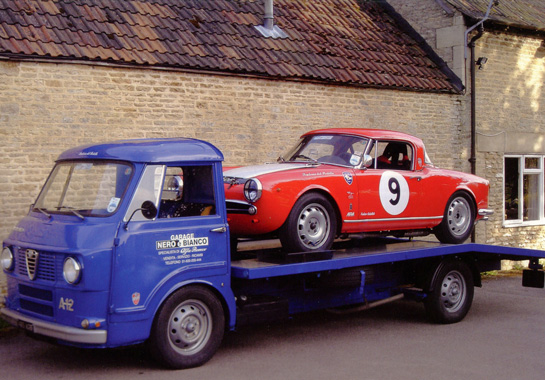
This is a 1972 1290cc Alfa Romeo A12 car transporter built by the firm of Scattolini in Verona. Only two are known to exist. Credit James Wheeler.
Cross doesn’t ignore transport by plane, train, ship and ferry either. In many cases, he provides a nice amount of detail.
Downsides to Inside the Paddock include very brief text in most cases. Trucks are very hard to identify given the images at hand…many of the shots are not great, but the only thing found and available. This reviewer nevertheless enjoyed every page of mostly unpublished photographs. Further, there are 19 pages devoted to Ferrari transporters and a further 9 to Maserati, 6 to Alfa, with many photos from the Spitzley-Zagari collection.
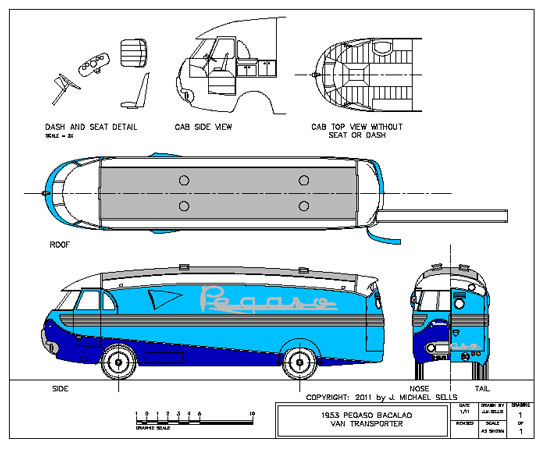
Pegaso's tranporter as depicted by Mike Sells. It was rarely used before sale to private team, then disappeared. There are over a dozen more such drawings at the back of the book 'Inside the Paddock'.
Inside the Paddock is as full of surprises as a walk through the real paddocks. Just when you thought it was over, Cross yields the floor to Mike Sells, a fellow Duluthian who creates model transporters and extremely beautiful color transport scale drawings. Please read Racing Transporter Art also in this issue about Mike and his work.
Wow !! just love that 1924 Mercedes Transporter , I have never seen that photo anywhere before , now what would that with the racing car be worth today ? Thanks VT !
Pete, I found the book fascinating as well, not only for the featured title subject, but all the unique pictures of various race cars in settings not often seen. Also, the pictures of the various racetracks, like the ‘Ring, from the paddock perspective are terrific.
David is already planning a followup book, and it will feature many American haulers of this same era. Should be even more interesting to your US readers.
Denton
Just getting into the “Fs” and enjoying every letter! A labor of love by the authors and wonderful design by Dalton-Watson. The photographs of the lesser known entrants or equipes highlight hard miles, long nights, small budgets and lots of grit.
COULD PAGE 262 HAVE 1938 MERCEDES gp CAR—(?) MUCH LOWEE THEN
W 125 MODEL?
The transporter behind Nuvolari is a Buessing .
They built heavy trucks ,but , became part of MAN,who is still building trucks today.
The Buessing name was dropped at the time of the takeover.
is there anybody out there who wants to sell his copy ???? please let me know….